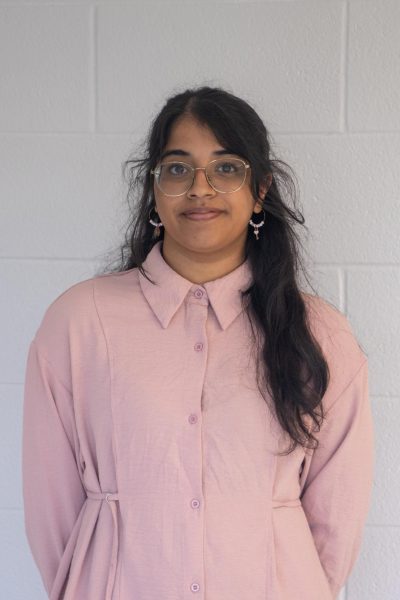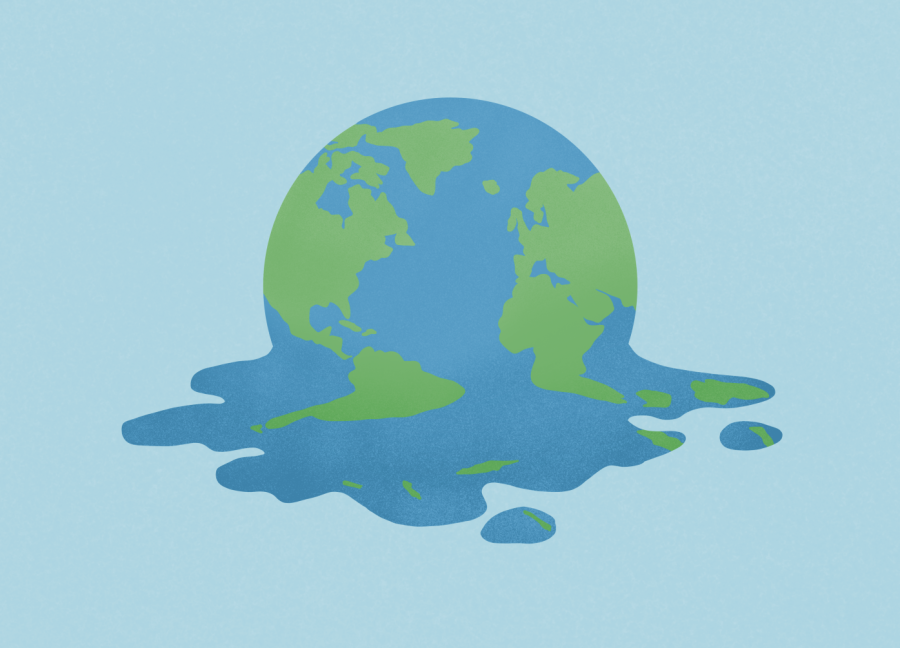Fighting for climate justice
Members of the Northwest community emphasize the disproportionate effects of climate change and the importance of becoming involved in ending them.
Digital illustration depicting Earth melting as a result of climate change and global warming.
The climate crisis is an ever-growing issue created by a system that consistently prioritizes profit over sustainability, and it is affecting all parts of the planet. Whether its effects are noticed or not, all people, regardless of their backgrounds, are being impacted by these circumstances.
“Climate justice” refers to the disproportionate effect of climate change on underprivileged, marginalized and vulnerable communities. It emerged from the thought that the responsibility of climate change lies with the wealthy and privileged while the effects of climate change regularly impact the poorest and most vulnerable communities the hardest.
The term itself was popularized in the 1990s and soon after the first Climate Justice Summit took place in 2000, where it was confirmed that climate change is an issue of rights. Since then, there have been many organizations created which are centered around educating about and working towards climate justice.
Senior Alicia Pham, the president of BVNW’s Environmental Club, said the topics of climate change and climate justice are very important to her. In fact, for Pham climate justice is what sparked her initial interest in the club. According to her, climate justice is a topic that is not only important, but necessary.
“It was a necessary term to have been created because of the fact that the results of [climate change] are affecting so many of those around us,” Pham said. “Climate change is the problem, and climate justice is one of the tools we’re using to remedy the issues.”
AP Environmental Science teacher, Sarah Derks, explained it is easy to ignore the impacts of climate change, especially when living in a richer country like the United States where the impacts of climate change are significantly less horrific than in poorer countries.
“Countries like Haiti, they’re being impacted by harder and sharper hurricanes. So they go into hurricane season already struggling financially,” Derks said.
While developing countries suffer, the U.S. continues to contribute massively to the planet’s greenhouse gas (GHG) emissions. Currently, America is the world’s second largest contributor to GHG emissions, after China. Pham explained that while rich nations continue to release greenhouse gasses into the atmosphere, smaller nations suffer through the major consequences of these countries’ actions.
“A [big part] of the issue is that the top 20 countries which produce the most carbon emissions don’t feel the effects like other developing nations do,” Pham said.“Islands off the coast of Indonesia, such as Fiji and Tuvalu, are currently sinking, and together they only contribute to about .05 percent of global carbon emissions,” Pham said.
Pham described this occurrence as one of the greatest representations of climate injustice today. Furthermore, Derks said that even as individuals, people tend to focus on how it impacts them instead of how it is impacting the world.
“The reality is that when we think about climate change, we become very individualistic and self-centered,” Derks said “We tend to be individualistic and not realize that we are a global society. We are part of a bigger world.”
Many people living within the U.S., especially those that are part of higher social classes, tend to view climate change as something disconnected from them, because they have not seen or felt the full effects of climate change firsthand. This type of thinking is common among individuals, but it could prove to be detrimental to society as a whole. Because of this, Pham stressed the increasing importance of all individuals taking the time to educate themselves as well as spread further awareness about climate justice.
“The topic of climate justice is something that [will be] affecting all of us in the near future. It’s already at a point where we can’t restore, but we can at least negate the damages that are occurring,” Pham said.
She explained that there are many resources students can access to educate themselves on the topic of climate justice, such as seeking out movements that focus on its achievement. Pham herself keeps tabs on various climate organizations, such as the Climate Justice Alliance, Indigenous Environmental Network and the Environmental Justice Foundation.
Achieving climate justice essentially means a transformation of the current system. Linking human rights to climate action, as well as having a people-based approach to climate actions are both crucial parts of accomplishing a successful and just transformation. The voices of frontline communities are often underrepresented in the talks surrounding climate change and climate justice. This ensures the representation, inclusion and protection of the rights of these most vulnerable communities.
“A lot of the actions currently being taken are less community-driven than they should be,” Pham said. “Instead, they prioritize big business actions even though they are the least affected by what is occurring.”
Derks agreed, saying that elevating the voices of these vulnerable communities and involving them in discussions is the key to creating solutions that encourage equity, ensure access to basic resources and provide future generations with a healthy and clean environment.
“The people who are the loudest are the ones being heard, and unfortunately, the people who need to be heard aren’t loud [enough]” Derks said.
Many organizations have outlined a “Just Transition” plan that would effectively combat climate change and protect biodiversity based on grassroots solutions. Climate Justice Alliance describes this as a “vision-led, unifying and place based set of principles, processes, and practices that build economic and political power to shift from an extractive economy to a regenerative economy.”
These Just Transition strategies were first created by labor unions and environmental justice groups that aimed to root out industries that harm workers, the community, and the planet; at the same time, they aimed to provide equitable pathways for workers to transition into other jobs. However, the first step towards climate justice is to be educated about the cause and the reason behind its creation.
“The purpose of climate justice is to represent and protect our most vulnerable people. That’s really the basis of what climate justice is in terms of equity and resources,” Pham said.

Nafsiya Hafiz is a senior and a writer for The Express. This is her third year as a writer for the newspaper. Outside of The Express, Nafsiya is president of the writing club and participates in the band program as a clarinet player. In her free time, Nafsiya enjoys crocheting, reading, hanging out with her friends and listening to one of her numerous playlists. Nafsiya is hoping for another great year and is incredibly excited to continue writing for The Express.

Sabrina San Agustin is a senior and the Design Editor for “The Express.” This will be her second year as Design Editor and third year on staff. Outside of newspaper, Sabrina is part of NHS, NSHS, NEHS, Quill & Scroll, and she is a board member for NAHS. Sabrina also owns her own business where she sells her art online. In her free time she enjoys spending time with family, reading new books and watching her favorite movies. Sabrina is very excited to return to the role of Design Editor and can’t wait to help tell stories through art and design.



![5th grader Swaraj Salvi works on his Honors Geometry assignment in class. His teacher, Katherine Lamp, said that he is great to have in class. “He's excited to explore more math [and] just comes ready to learn every day,” Lamp said.](https://bvnwnews.com/wp-content/uploads/2024/10/Screenshot-2024-10-09-at-2.37.52-PM-600x414.png)
![After drills during football practice on Sept. 25, Keon King exchanges jokes with his teammates. “I started talking to people [about] how I felt. I also decided to focus on being a better person and supporting others. I wanted to make sure people knew they had someone to talk to," King said.](https://bvnwnews.com/wp-content/uploads/2024/09/keon-king-mental-health-600x400.jpg)






